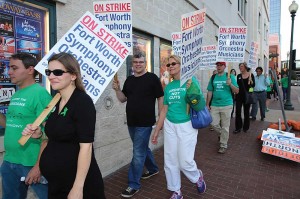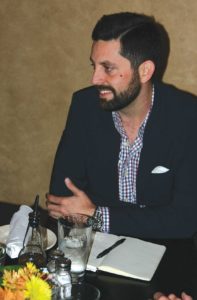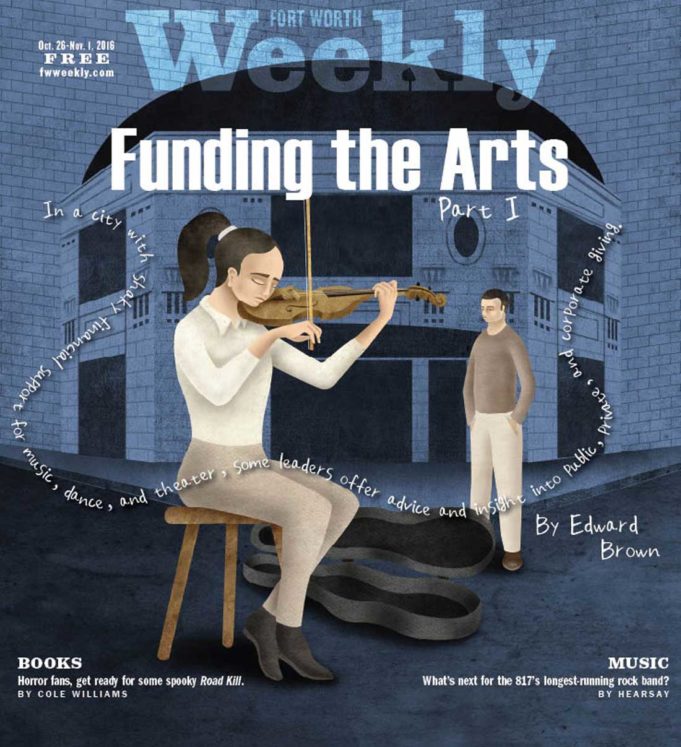Great performances aren’t the only things that are outsized about Fort Worth’s world-class arts groups. Funding is, too.
While festivals by the Fort Worth Opera and performances by Texas Ballet Theater and others are almost taken for granted as part of our city’s milieu, these nonprofits rely on several funding sources (corporate, individual donors, government, and foundations) to run in the black. Giving fluctuates year to year, and chasing the money is a full-time job for many arts directors.

The several dozen musicians of the Fort Worth Symphony Orchestra are in the midst of an ongoing strike that has led to the cancellation of orchestra concerts through the end of December. FWSO management is asking the musicians to take a temporary pay cut to shore up losses from dwindling corporate and individual giving. But the performers aren’t buying the deficit projections. The musicians believe FWSO leadership is giving up early, despite North Texas’ economic prosperity and the fundraising successes of similar-sized orchestras across the United States.
The FWSO is only the most recent performing arts group to face drastic funding cuts and slashes to programing. The 55-year-old TBT, citing its own budget shortfalls, has been using recorded music in lieu of the FWSO since the 2009-10 season, reintroducing live music only recently. Two summers ago, FWO postponed the world premiere of A Wrinkle in Time, a work that came with an estimated price tag of $1.2 million. Fund-raising tallies from the year before left the project unaffordable. A prominent local arts director who asked not to be named told me that the lack of support from corporations and local government for arts groups is “killing” the arts.
Is there a way out of this cycle? Most city leaders, Fort Worthians, and even tourists all agree on one thing — the arts are an indispensable part of Fort Worth’s image and way of life.
This is the first in a two-part series. We’re tackling the issue now because the FWSO’s recent financial straits highlight vulnerabilities that affect nearly every local arts group. In conversations with arts leaders, both performing- and visual-based, the consensus is that the money is out there, but there needs to be more direct support from business and community leaders. Given the different worlds in which performers and visual artists live, we separated the conversations. For Part I, I sat down with three performing arts directors: Clint Riley, executive director of the North Texas educational organization Texas Center for Arts + Academics, who manages two charter schools (Fort Worth Academy of Fine Arts and Texas School of the Arts) as well as the Texas Boys Choir, Singing Girls of Texas, and Texas Dance Conservatory; Fort Worth Opera director of development Mark Saville, who recently left his fundraising position at Arizona Opera to work for FWO and who organized a campaign that raised more than $1 million for FWO last summer; and Hall Ensemble cofounder and cellist Karen Hall, who is also a member of FWSO and whose namesake ensemble relies on a patchwork of individual donations and grants.
Brown: Mark, one of the biggest drops in arts funding has come from corporate giving. When you moved here last year from Arizona, describe your experience approaching Fort Worth businesses for support. How did that experience compare with your time at Arizona Opera?
Saville: After moving to DFW, I expected it to be far easier to fundraise with corporations just given the number of Fortune 500 companies in the area. I was quite surprised by what I found. There has been a dramatic decline in corporate giving. In 2008, Fort Worth Opera raised $430,000 in corporate donations. In 2016, that dropped to $80,000. Thus far, [we are projecting] $34,000 in corporate giving for 2017. The interesting thing is that in 2008, the $430,000 came from 33 corporations. In 2016, the $83,000 came from 32 [corporations]. The numbers are the same, but the quantity per gift has diminished dramatically. The same corporate sponsors who gave us $60,000 or $75,000 per year are giving $5,000 or less now.
Brown: Do you have a theory about why corporate donations have dropped?

Saville: I think that happened nationwide when the recession hit. Many organizations found it difficult to justify $50,000 or $60,000 sponsorships for [classical music]. Instead, I think shareholders requested profits be reallocated toward health and human services, things that were easier for them to justify publicly and things that were of great need at the time. Habitat for Humanity and food banks did tremendously well. Coming out of the recession, however, the pipeline was never turned on again for arts and culture. We’re having to make ourselves relevant in the public eye again.
Brown: You said you’ve made inroads with a few businesses recently. How did you do that?
Saville: It was two ways: one was through the million-dollar summer fundraising campaign. I’m new to Fort Worth. It’s difficult being the new guy in town and getting an audience with business leaders from major financial institutions when you don’t have an established reputation. We created a social media campaign that allowed these business directors to state their support for the arts through a photograph statement. We gave them a laminated sign to hold that read, “I support Fort Worth Opera because …” and gave them the space to articulate why the arts are important. What started as a way to highlight our campaign grew into a public call for everyone to support the arts in general. That allowed me to create personal relationships with corporate executives I wasn’t going to be able to get to otherwise. I had a 45-minute audience while they were getting ready for the photoshoot, and I gave them the elevator pitch.
The other breakthrough came from our programming. We came to the realization that our programming had to evolve to stand out from everyone else’s. We do classical opera tremendously well, but at the same time we knew we had to build a contemporary audience that was reflective of that community. We decided to dedicate the next four years to an initiative that’s designed to build a Latino audience. No opera company has ever dedicated four years of repertoire to make inroads with the Latino community. By 2025, Latinos will be the overwhelming majority here. Corporations are seeing our idea as a bold step in what they consider to be the right direction.
Brown: Give me an example of this new program?
Saville: We are presenting repertoire that is familiar to them. Our first piece [Cruzar la Cara de la Luna] is about border issues and immigration. It’s a hot button issue. We want to use the opera as a platform to have conversations in a safe space. By using a familiar musical medium, mariachi, we’re able to entice a new audience into Bass Hall for the first time. It’s part of our effort to shift from being a performing arts organization to a community-building organization.
Brown: Clint, going off this idea of business involvement, tell us about the Business Council for the Arts and how Fort Worth could benefit from having one. It’s my understanding that you’re working on bringing the program here.
Riley: Business Council for the Arts was started in Dallas by Ray Nasher 28 years ago. Basically, the founders wanted to find a way to get business support for arts organizations, and the council offered the business community a way to step in and help nonprofits. What [the business council] does is develop partnerships with corporations by identifying people who would like to receive training as [nonprofit] board members. The corporations sponsor employees to participate. Corporations get the benefit of having greater community buy-in. The nonprofit organizations are beneficiaries because the Business Council for the Arts places those newly trained board members onto boards of organizations that align with their personal affinity. The process builds a pipeline for [nonprofit] board membership, for better governance, and for sustaining good governance practices for those charities.
Brown: How far along are you in bringing this concept to Fort Worth?
Riley: I’m looking to find a core of organizations here in Fort Worth that is willing to help get resources together so the [business] council can open a group here. I don’t think we need to start over. I believe in learning from people who are already experts.
Brown: Speaking of nonprofit boards, what challenges do you face in recruiting new members?

Riley: One challenge is trying to identify people who have experience and who can bring their expertise to support the organization. But I find people are very busy and already committed. The business council idea would be an opportunity to tap into that [private business] knowledge base to find resources that are already here. You can find experienced board members, and you can find people who are really passionate about supporting nonprofits, but they need training.
Brown: Is diversity a problem for Fort Worth’s nonprofit boards?
Riley: One great thing about Fort Worth is that we have several committed families who believe in the importance of the arts. [But that often skews] Fort Worth organizations to think, “Oh, it’s critical that we can get a member from this prominent family or that family.”
Brown: What’s the danger there?
Saville: I think the danger is that people seem to think if you get one person from this corporation or one person from this family that it is going to solve all of your problems, and it doesn’t work that way. These people already have various commitments. They can only dedicate the majority of their resources to a few passions.
Brown: Karen, what type of involvement do you ask of your board members?
Hall: I have a lot of board members who don’t sit on other boards. They’re not super-wealthy, but they have kept me going. They have made significant donations. Part of that’s because they aren’t on five or six other boards. They’re devoted to my organization. Part of the problem of being on so many boards is that you’re expected to go to every concert, too.
Brown: Your group has a smaller budget and fewer resources for fundraising. How have you managed to stay in the black?
Hall: I have made a huge effort over the last 10 years to make every relationship personal. Yes, I only have 100 people coming to my concerts, but I know all of them. I thank them for being there and taking the time to come. I get enough small gifts to keep the organization going. I would caution anyone against ever lecturing their client base and patrons. Patrons will be more ready to make a donation because they feel they are good enough to be part of an arts organization. We get so serious about what we do as musicians, but I don’t think it’s being serious that makes people write checks. Art should be uplifting, joyous. We need to communicate that.
Brown: What are some other keys to sustainable fundraising?
Riley: There are people in this community who want to help but don’t know how. So how can we as organizations tell them how to help, whether through fundraising or board service? We have to be open and involved in our community in a way that they can find a way to connect with us.
Brown: Speaking of community, Texas Center for Arts and Academics recently expanded its fundraising program to reach people outside its charter schools. How well has that worked?

Riley: When I arrived almost four-and-a-half years ago, we didn’t have a formal fundraising program. There was a gala event, but we hadn’t done a lot of individual solicitation. Our [state] funding comes in at $1,200 lower [per student] than most public schools. We started with a simple solicitation with our community. I wrote a message saying, “These are things we’re doing for you, and we can’t do it without you. In the same way, we also cannot do it without financial resources.” We started really simple and were surprised by the number of people who responded to that first solicitation. That evolved into what is our Join Our Movement campaign. We built this campaign as a driver for our schools, but we’re also putting it out in the community because we believe the value of arts and education is really powerful for building a really great community. It’s our first year of moving out into the community at large. We have a team of parent-leaders, and we are asking our board members to identify people within their circles to join our movement. A little over $80,000 has been raised so far this year.
Brown: What’s the ideal balance between small and large donors?
Riley: From a fundraising standpoint, you need to have a broad base of support that is tapered with larger gifts. You want your entire community supporting you on some level while understanding that not everyone can write a check for $1,000 or even $100. Any gift, no matter what size, tells you that the community is supporting you. I think that broad base is critical.
Brown: Mark, how much of your work focuses on small donations and why?
Saville: I’d rather have one thousand $250 donors than one $250,000 gift because, as we’ve seen with the downturn of oil and gas, angels disappear overnight, and what are you left with at that point? If you lose a handful of $250 donors, you can go out and find more. Like Clint was saying, the size of your base is a testament to the impact you have on the community. You have to think about diversifying the way you fundraise.
Brown: Given the number of large foundations and wealthy benefactors in Fort Worth, I imagine there is a perception, in at least part of the community, that there’s a magic pot of money waiting to save this or that arts group.
Riley: That’s what the assumption is when you don’t ask and if we aren’t transparent. I don’t mean to say we should be in a constant “We need you” crisis mode. We’re here to serve the community. Community support ultimately keeps the lights on, keeps the performances going, and keeps us going into schools so we can train the future supporters of the arts.
Saville: Fort Worth Opera has a $1 million endowment. The truth of the matter is that an endowment has to be of a certain size and scale to annually yield anything significant. An organization of my size needs $20 million to yield anything that can support operations when we’re running a $4 or $5 million budget. A $1 million endowment hardly yields anything, but people see that and think it’s a lot of money.
Brown: If arts funding is inevitably tied to public support, how do groups like yours ensure they are still around in 20, 50 years?
Saville: We are 50 percent of the city’s tagline. I think organizations shouldn’t have to reinvent themselves every three years, but they have to innovate. More than ever, we require our leaders to be visionaries who foresee troubles on the horizon and move the boat appropriately before hitting that iceberg. We need to be smart in the way we budget and artful in the way we program. All these things are ways to stay relevant and important to the city.
Riley: We’re here to serve the community. With that being said, we have to be a part of our community and listen to all of our community. We have to make ourselves integral. Once you can do that, and I’m not saying times won’t get lean, [but] there won’t be a danger of your group going away.
Brown: Karen, you’ve lived here for a few decades. Are these problems new to Fort Worth?
Hall: In my 35 years here, I have seen funding dollars move around like a school of beautiful golden fish. They go toward what is the most compelling thing that moment. I remember in the depths of the recent recession, TCU raised $250 million. They had to shut down the campaign because they made way more money than they set as their goal. Some organizations are very well-funded, and others are struggling. To me, there’s a need to make the struggling organizations more compelling and let them in on the conversation. There is a lot of money in the community. It just depends on where it’s going. We have to get that school of fish to come back to the performing arts.













Way to go, Karen Hall!
If lack of corporate funding is killing the arts, how have the Dallas Symphony and the Dallas Opera managed to grow over the last few years?
The FWSO is not in its current situation because “corporate giving is down.” It’s because the FWSO has a CEO who is a failure and a board that isn’t doing anything about it. The FWSO already went through this in 2010, yet for the last six years they haven’t had a capital campaign, an endowment drive, or anything innovative, for that matter. Their only solution is to cut.
The Fort Worth Symphony’s problems are based on “projected” deficits in the future. They have no outstanding debt! Yet, they want to cut the musicians salaries – AGAIN!
Why doesn’t Mr. Brown ask the basic question “Why don’t they try some of these new fundraising ideas first?” Instead of just assuming its the corporations fault.
This article leads with the assumption that the FWSO’s problems are inevitable and not of their own making. CEO, Amy Adkins has had 5 years to do something and she has failed. That’s the real problem.
The beginning of this article is totally misleading. You make it sound like all the arts groups are still down. That is just not true. The Texas Ballet Theater has bounced back. They brought live music back two years ago and they are growing their budget 50%. Yes, the Opera canceled one opera a few years ago but they just put on an amazing premier of JFK this year! And you leave out the fact that the FWSO already took a huge downsizing in 2010 and now their management wants to do it again. It sounds like you wrote this article 4 years ago. Fortunately, your interviewees contradict your conclusions.
Great interview, Eddie. The directors you interviewed seem to have great insight into and understanding of the art of fundraising. They have given me hope that there is a future for the arts, especially the performing arts, in Fort Worth. I congratulate all of them for their efforts and successes to this point. My hope is that all of us will learn from them.
The truth is, there are so many errors of fact and purpose in this article that I can hardly get past the opening four paragraphs to read the interview.
The article states that “several dozen musicians of the Fort Worth Symphony Orchestra are in the midst of an ongoing strike.” As if “some” of the orchestra would prefer not to strike.
I have seen orchestra members picketing and performing together in their own venues. In fact, they seem united in their disgust with the way the management has defaulted in doing their job.
“FWSO management is asking the musicians to take a temporary pay cut to shore up losses,” but the fact is that the management asked the musicians to take a pay cut in 2010. For six years the musicians have worked for less money than they did previously.
In effect, this amounted to over $3 million dollars donated to the orchestra by the musicians. Now, the management rewards their donation by offering another pay cut. You know, sometimes no job is better than a job where they slowly, cut your pay until you leave. That’s what a strike is.
Back in 2010 the management told the musicians that they would the time their donation provided to fix their problems and shore up funding. In fact, the management did nothing about the problems for six year.
“Chasing the money is a full-time job for many arts directors.” Chasing money is not supposed to be the job of the arts director. The arts director is supposed to HIRE someone to build a support base that keeps them from chasing anything. But the FWSO management appears to work in crisis mode. They don’t even “chase” money because the position of Development Director (the person who should be “chasing” donors) has been either vacant or occupied almost half the time since 2010, six long years. They are currently seeking their 7th DD in the last five years.
The whole attitude about fund raising is wrong in the article and wrong in the FWSO management. No wonder the musicians don’t trust that the offer of another pay cut by the management has a future. Management knew this would come to a head and they still did nothing for six years.
I don’t know the goal of FWSO management but I know it doesn’t parallel other orchestras in the nation or the state. Dallas’ symphony balanced their budget and acquired an additional $5million gift. The Charlotte Symphony developed a single $2million gift (almost as much as the FW musicians donated to their own orchestra’s operation). The Houston Grand Opera raised over $170 million (is there a BOLD button) this year.
And the FWSO management wants to fix their problems by asking the already-penalized-musicians to take another pay cut? Remember, they still haven’t hired a Development Director.
As I said, I don’t know what the goals of the FW management are, but there a shoals ahead and somebody better change the direction of the ship soon.